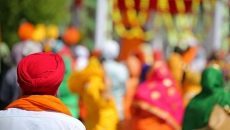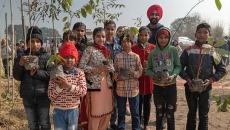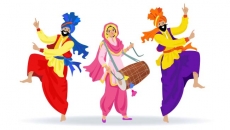Waheguru ji Ka Khalsa
Waheguru ji Ki fateh
Hola Mohalla is an important Sikh festival that occurs the day after the Holi festival. "Hola" is derived from the word halla (a military charge), and the term "Mohalla" stands for an organized procession such as an army column.
After the creation of Khalsa in April of 1699 with the concept of Saint & Soldier, Shree Guru Gobind Singh ji Maharaj organized the first procession accompanied by drums at Holgarh fort in Anandpur Sahib, the City of Bliss in 1701. The new tradition of overseeing mock battles and poetry contests has since spread from the town of Anandpur Sahib to the rest of the world.
Guru Ji made Hola Mohalla an occasion for the Sikhs to demonstrate their martial skills in simulated battles. Exhibitions, displays of weapons, etc., are held, followed by Kirtan, music and poetry competitions. The participants perform daring feats, such as Gatka (mock encounters with real weapons), tent pegging, bareback horse-riding, standing erect on two speeding horses and various other feats of bravery.
A sea of new saffron and deep blue garb adorned by the Nihangs, a captivating display of shining weapons, speeding horses whipping the wind, and incredible feats of bravery - the Holla Mohalla is indeed a spectacular display of courage and prowess.
“Holi Kini Sant Sev Rang Laga Aat Laal Dev”
In Shree Guru Granth Sahib ji, Guru Arjan Dev ji states that we develop unconditional Love with Waheguru ji by spending time with God-oriented people. It is as if our consciousness is playing Holi with permanent and everlasting colours of Devotion that will never fade away. As a result of his Love for God, all his doubts, anguish, and adversities have disappeared.
“Jaisa Rang Kusambh Ka Taisa Yeh Sansar
Mere Ramiya Rang Majith Ka Keh Ravidas Chamar “
In another verse, Bhagat Ravi Das Ji describes divine love as a permanent colour that brightens his life permanently, contrary to other short-lived loves of this world.
According to Shree Guru Gobind Singh's court poet Bhai Nand Lal, the participants threw colours after the mock battles: rose water, amber, musk, and saffron-coloured water. Sikh tradition holds that Guru Gobind Singh also participated in the colourful festival using Gulal, which has survived to modern times with Nihangs splashing gulal and red powder on each other and the audience.

“Laal Rang Tis ko Laga Jis Ke Vadhbhaga Maila Kadey no Hovey na Lagey Daaga “
With such good grace, our soul takes on the colour red, the colour of love. Once it dyes, our thoughts, actions, and commitments will never get dirty.
"Soora so Pehchania Jo Larey Deen ke Heth
Poorja Poorja Kat Marey Kabhoon na Chadey Khet"
A True warrior once engages in a battle to uphold Truth, Righteousness, and Faith, will not leave it even if his body gets cut into tiny pieces.
“Rang Laagat Laagat Laagat hai Brahm Bhagat Bhagat Bhagat hai “
As we get coloured with the Love of Divinity, our doubts get dispelled. Duality changes into oneness.
"Jin ke Choley Ratrey Pyarey Kantt Tinha ke Paas "
Devotional love brings union with Husband God.
Let's all Learn the values and virtues of Hola Mohalla and practise those martial skills of courage and defense preparation to uplift humanity with brotherhood, love, respect, and tolerance.
The values of Hola Mohalla resonate with Canadian values as well.
Waheguru ji Ka Khalsa Waheguru ji
Waheguru ji Ki Fateh







